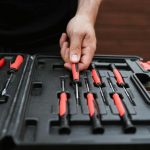When you're working with rivets, it's easy to overlook some critical steps that can lead to costly mistakes. You might think choosing any rivet will do, but matching the right type to your materials is crucial. Similarly, if you skip proper hole preparation or neglect tool maintenance, you're setting yourself up for failure. Understanding these fundamentals is just the beginning, though. There are several common pitfalls that can compromise the integrity of your work, and knowing how to avoid them can make all the difference in your projects. What's the first mistake you need to watch for?
Table of Contents
Key Takeaways
- Select the appropriate rivet type and ensure material compatibility to prevent corrosion and joint failure.
- Prepare holes accurately and clean them thoroughly to ensure a secure rivet hold.
- Maintain cleanliness of surfaces and ensure proper material preparation for effective bonding.
- Regularly inspect and maintain tools to ensure optimal performance and safety during riveting.
Choosing the Wrong Rivet Type
One of the biggest mistakes you can make is choosing the wrong rivet type for your project. When you select a rivet, you need to consider factors like the materials you're joining, the required strength, and the environmental conditions. Different rivets serve various purposes, so understanding your project's needs is crucial.
For instance, aluminum rivets are lightweight and corrosion-resistant, making them ideal for aircraft and marine applications. If you're working with steel, you might opt for steel rivets for better strength and durability.
Don't forget about the different head types, like flat, round, or countersunk, as these can impact the overall appearance and functionality of your joint. Also, think about the rivet's diameter and length. A rivet that's too short won't provide a secure hold, while one that's too long can create excess material that may interfere with surrounding components.
Always match the rivet type to the specific demands of your project to ensure a strong, lasting bond. By taking the time to choose the right rivet, you'll avoid unnecessary headaches down the line.
Improper Hole Preparation
When it comes to riveting, improper hole preparation can lead to major issues.
You need to ensure the hole size is accurate, keep it clean of debris, and account for the material thickness.
Neglecting these factors can compromise the integrity of your rivet joints.
Hole Size Accuracy
Ensuring precise hole size is crucial for achieving strong, reliable rivets and preventing structural failures. If your holes are too small, you won't be able to fit the rivet properly, which can lead to misalignment and weak connections. On the other hand, if the holes are too large, the rivet won't grip effectively, compromising the joint's integrity.
To avoid these issues, always use the correct drill bit size based on the specifications of the rivets you're using. Double-check the measurements before you start drilling, and don't hesitate to use a caliper for accuracy. If you're working with different materials, remember that each may require adjustments in hole size due to varying thicknesses and hardness.
Another common mistake is overlooking the effects of heat or wear on your drill bits. Dull bits can create oversized holes, so regularly inspect and replace them as needed. Lastly, ensure your drilling technique is steady and consistent; any wobbling or tilting can lead to inaccuracies.
Cleanliness and Debris
How can neglecting cleanliness and debris affect the strength of your riveted joints?
When you overlook this crucial aspect, you risk compromising the integrity of your connection. Dirt, rust, and other contaminants can interfere with the rivet's ability to form a solid bond. This can lead to joint failure under stress, which is something you definitely want to avoid.
Here are three common debris-related issues to watch out for:
- Surface Contaminants: Oil, grease, or paint can prevent proper seating and bonding of the rivet, weakening the connection.
- Metal Shavings: Leftover shavings from drilling can create gaps or misalignments, leading to a less effective rivet.
To ensure successful riveting, always clean your holes thoroughly before riveting.
Use appropriate cleaning methods to remove all debris and contaminants. Taking the time to maintain cleanliness will lead to stronger, more reliable joints in your projects.
Don't underestimate the significance of proper hole preparation!
Material Thickness Considerations
Neglecting proper hole preparation not only involves cleanliness but also requires careful consideration of material thickness to avoid weak riveted joints.
When you're working with materials of varying thickness, you need to ensure that your hole size accommodates the rivet properly. If the hole is too large relative to the rivet or if the material is too thin, it can lead to insufficient grip, compromising the joint's integrity.
Before you start riveting, measure the thickness of the materials accurately. For thicker materials, you might need larger rivets to ensure a secure hold. Conversely, using a rivet that's too large for thinner materials can lead to deformation or shearing.
Additionally, consider the type of rivet and its specifications. Different materials and thicknesses require specific rivet sizes and types for optimal performance.
Always double-check your hole size and the rivet's compatibility with the materials in use. By paying close attention to these details, you'll significantly reduce the risk of weak joints and ensure a more robust and reliable assembly.
Proper hole preparation is crucial, so don't overlook it!
Inadequate Tool Maintenance
Inadequate tool maintenance can lead to poor riveting results and increased safety risks. When your tools aren't properly maintained, you might find that they don't function as intended, which can cause issues during the riveting process. Regular upkeep is essential for ensuring both the quality of your work and your personal safety.
Here are three key maintenance tasks you should prioritize:
- Clean your tools regularly: Dust, debris, and metal shavings can accumulate and impact performance. A quick clean after each use goes a long way.
- Inspect for wear and tear: Check for any signs of damage or excessive wear on your riveting tools. Replace worn parts to maintain optimal function.
Incorrect Riveting Technique
When it comes to riveting, using the wrong technique can lead to big problems.
You need to ensure you're using the right tools, preparing your materials properly, and selecting the correct rivets for your project.
Let's break down these common mistakes so you can achieve a secure and reliable finish.
Improper Tool Usage
Using the wrong tools or techniques can lead to weak rivets and failed joints, so it's crucial to choose the right equipment for the job.
Improper tool usage often stems from a lack of understanding of how each tool functions. To avoid mistakes, ensure you're using the right tools for your specific riveting task.
Here are three key aspects to consider:
- Rivet Gun Selection: Choose a rivet gun that matches the size and type of rivets you're working with. A mismatched gun can lead to inconsistent results.
- Correct Nozzle and Die: Using the wrong nozzle or die can affect the rivet's formation. Make sure these components are compatible with the rivets to ensure a proper fit and strong joint.
Inadequate Material Preparation
Proper material preparation is essential for ensuring strong and reliable riveted joints, as neglecting this step can lead to misalignment and weak connections.
Before you start riveting, make sure the surfaces you're joining are clean, flat, and free from contaminants. Dirt, grease, or rust can compromise the integrity of the joint, so take the time to thoroughly clean each surface.
You should also check that the materials are properly aligned before inserting the rivet. Misalignment can cause uneven pressure during the riveting process, resulting in a weak joint. Use clamps or jigs to secure the materials in place and maintain their alignment throughout the riveting.
Additionally, consider the thickness and type of materials you're working with. If they're not compatible, the rivet may not hold securely.
Always measure and mark the rivet locations accurately to avoid unnecessary stress on the joint.
Incorrect Rivet Selection
Selecting the right rivet for your project is just as important as preparing the materials, as an incorrect choice can lead to structural failure and safety hazards.
When you're choosing a rivet, consider the following factors to avoid making a costly mistake:
- Material Compatibility: Ensure the rivet material matches the materials you're joining. For instance, using aluminum rivets on steel can lead to corrosion.
- Load Requirements: Assess the load the joint will bear. A rivet that's too small won't hold under pressure, while one that's too large can create unnecessary stress.
Failing to Control Heat
Failing to control heat during riveting can lead to weak joints and compromised structural integrity. When you apply excessive heat, you risk altering the material properties of the rivets and the surrounding metal. This can cause issues like warping, weakening, or even melting the materials involved.
To maintain proper heat control, monitor the temperature closely throughout the riveting process. Use a reliable heat source and consider investing in a thermometer or thermal imaging tool to check temperatures accurately. Aim to reach the optimal temperature for the specific materials you're working with, as different metals have unique heat requirements.
Additionally, avoid overheating the rivets by keeping your heat application consistent. If you notice any signs of distress, such as discoloration or excessive smoke, stop immediately and reassess your heating technique.
Neglecting Material Compatibility
Neglecting the compatibility of materials can lead to serious issues, compromising the strength and durability of your riveted joints.
When you choose materials that don't work well together, you risk creating weaknesses that can cause failure under stress. To avoid this mistake, consider the following key factors:
- Thermal Expansion: Different materials expand and contract at different rates. If you mix materials with vastly different thermal expansion coefficients, your riveted joints could loosen or even crack over time.
- Corrosion Resistance: Some materials are more susceptible to corrosion when in contact with others. For instance, if you rivet aluminum to steel without proper protection, galvanic corrosion can occur, leading to premature failure.
Skipping Quality Inspections
Skipping quality inspections can lead to hidden flaws in your riveted joints, jeopardizing their integrity and performance. When you forgo these crucial checks, you're essentially gambling with the strength and reliability of your work. You might think you're saving time, but in reality, you're setting yourself up for potential failures down the line.
Regular inspections allow you to catch issues like improper rivet placement, inadequate compression, or even material defects before they escalate. These problems can compromise the entire structure, leading to costly repairs or even catastrophic failures. Trust me, the last thing you want is to have to redo a project because you skipped a simple inspection.
Make it a habit to conduct thorough quality checks at every stage of the riveting process. Use tools like gauges and visual inspections to ensure everything meets your standards. Encourage your team to adopt this mindset as well.
The time invested in quality inspections will pay off in the long run, enhancing both safety and durability. Remember, a well-inspected joint is a reliable joint. So, don't cut corners—commit to quality and safeguard your projects from unnecessary risks.
Frequently Asked Questions
What Personal Protective Equipment Is Recommended for Riveting Work?
When riveting, you should wear safety glasses to protect your eyes, gloves to shield your hands, and hearing protection to guard against noise. Steel-toed boots will also keep your feet safe from heavy materials.
How Can I Safely Dispose of Defective Rivets?
To safely dispose of defective rivets, collect them in a sturdy container, ensuring they won't cause injury. Check local regulations for disposal methods, and consider recycling if the materials are suitable for it.
Are There Specific Safety Regulations for Riveting in Construction?
Yes, there're specific safety regulations for riveting in construction. You should always wear proper personal protective equipment, ensure adequate ventilation, and follow guidelines set by OSHA and other relevant authorities to maintain a safe working environment.
What Are the Signs of a Successful Rivet Installation?
You can tell a rivet's installed successfully by checking for a tight fit, uniform appearance, and no gaps. Listen for a solid sound during installation, indicating proper compression and secure bonding within the materials being joined.
How Do Environmental Conditions Affect Riveting Processes?
Environmental conditions, like temperature and humidity, impact your riveting process significantly. Extreme heat can soften materials, while cold can make them brittle. Be mindful of these factors to ensure a successful and durable rivet installation.
- Does Chiffon Fabric Stink - July 15, 2025
- Does Chiffon Fabric Affect the Economy - July 15, 2025
- Does Cotton Fabric Have a Nap - July 15, 2025







